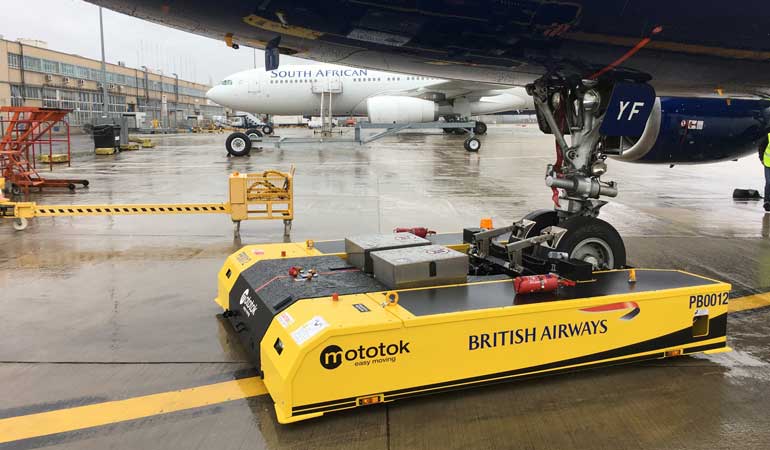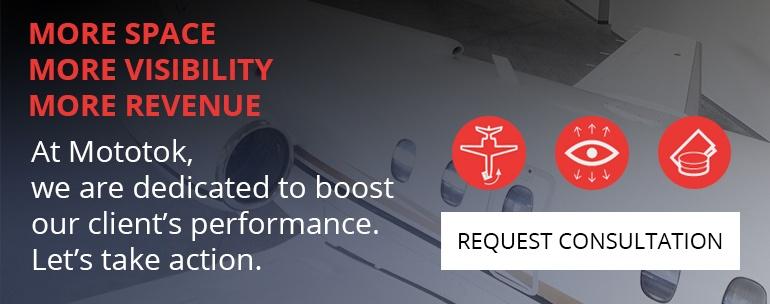What are the flaws about the conventional pushback operation?
The usual pushback operation you see at airports all around the world is performed by a pushback tractor and up to four people. In the worst case the pushback tractor still uses a towbar (if you want to know why this is a bad idea you should read this article). But even most towbarless tugs still require additional personnel to supervise the pushback operation in order to ensure that the aircraft keeps a safety distance throughout the whole process. From a position next to the nose gear the driver simply can’t maintain overviews of the plane’s dimensions on his own.
Furthermore, the fact that one pushback tractor is often in charge of a high number of gates is a problem when it comes to punctuality. When each pushback operation takes a long time already, every slight shift in the schedule can make for a notable delay.
From a parking device to a pushback tug
When Kersten Eckert built the first Mototok, he didn’t exactly have a pushback tug in mind. It was supposed to be a tool for moving aircraft into and out of the hangar. Years later – 2015 to be precise – Mototok’s concept was basically still the same, but its application was about to find a new purpose.
At the Inter Airport Europe 2015, Mototok was discovered as a possible pushback tug for the first time. Shortly after, we did some tests in Copenhagen, Denmark, to see how our Spacer model performs under cold, icy and wet conditions. We realized that our tug wasn’t optimized for daily pushback operations. Time to adapt!
We simplified the maintenance by hiding all the main parts under one lid. The sensors of our tugs were improved and could now resists even the harshest weather conditions. The pushback tugs we build today can in fact be connected to a computer via Wi-Fi for an even easier maintenance process.
Feature after feature we designed the Spacer model that is used for pushback operations today. It is the result of uncountable improvements and tests to create the most advanced pushback tug out there.
How does a terminal implement electric tugs as pushback tugs?
Switching from conventional aircraft tugs to remotely controlled electric pushback tugs is not easy. In the beginning, one big concern was that the frequencies used could interfere with other machines and cause disturbance. Extensive testing made sure that the implementation of Mototoks would pose neither a physical nor a technical risk.
Another critical point is the infrastructure. When dozens of pushback tugs are charging simultaneously during the night they need a lot of electricity. Therefore the airport’s infrastructure plays a crucial role. It has to be able to provide enough power for all the pushback tugs in use. Alternatively, it is necessary to work with charge cycles and intelligent charging periods. That means that pushback tugs that are not currently used seize the opportunity to charge in between pushbacks.
One possible implementation is that each Mototok covers three gates and has its own charging station. With one full charge it can finish its day’s work (about 30 pushback operations; even more if the turbines stay off) with ease. Thus the waiting periods in-between each pushback operation are reduced and you minimize the risk of pushback tugs not being available.
The ideal number of Mototoks a terminal should use depends on the number of flights it handles. Very busy airports can even use one Mototok per gate to minimize waiting times in between pushbacks and always have a tug ready-at-hand.
What are the benefits of using Mototok’s aircraft tugs for your pushback operations?
In aviation, new tools often go unnoticed by the people who aren’t working with them directly. But the way an electric pushback tug alters the whole pushback workflow can’t be denied. Here are the main benefits for…
...the passengers
Only a very few passengers pay actual attention to the pushback tug that starts of their journey. How are they supposed to notice any difference? Well, in the best case they don’t. They will probably notice so little that they won’t even realize the plane is already in motion. Comfort and smooth movement are a big advantage of electric tugs. Say goodbye to rough starts!
Another big benefit every passenger will cherish: Punctuality. The whole concept of Mototoks as pushback tugs serves the purpose of providing trouble-free pushback operations. Time is an important factor in the mix – not only for passengers.
...the airport
Flights starting on time are a huge deal for airport operators. Every delay jeopardizes the schedule and affects other flights, too. Not being able to perform a pushback whenever you need to is therefore quite aggravating. Sometimes there are just too few pushback tugs available, or even if they are, the attachment of a towbar can cost a huge amount of time, too. With one Mototok for every three gates these waiting time is reduced to a minimum (in comparison: Usually, there is one pushback tug for 5-10 gates). The huge advantage: Everyone can operate it! It only takes a 2-hour-training to be able to handle our pushback tugs, so you no longer depend on professional tug drivers to be available at any time.
Especially at very busy airports every minute an aircraft has to wait for its departure costs bare cash. Keeping jet engines running for no particular reason wastes a huge amount of fuel alone. Reducing this waiting time doesn’t only save money. It helps reducing pollution, too!
…the airline/ramp handling service company
Always being on time is a major advantage if you want to stay ahead of your competition. The benefits for the passengers and the airport are therefore in conclusion benefits for the airline and the ramp handling service company as well. Unlike other investments to remain competitive Mototok however offers a massive savings potential. Way smaller maintenance and personnel costs, and zero fuel costs speak volumes.
Conclusion to the implementation of Mototoks as pushback tugs – the future of pushback operations?
Using Mototoks as pushback tugs is not only possible but also very lucrative. We are incredibly proud to be co-creating the future of aviation and we are convinced that there will be plenty of airports to host this new technology in the near future. One obstacle for the implementation is the infrastructure of the airport at hand, but clever charging cycles can bridge this gap.
Are you searching for a profitable, safe and simple pushback solution? Get in touch with us and find out how you can revolutionize your pushback operations!



Comments